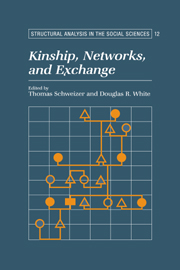Book contents
- Frontmatter
- Contents
- Preface
- List of contributors
- 1 Revitalizing the Study of Kinship and Exchange with Network Approaches
- I Representing Kinship Dynamics, Material Flow, and Economic Cooperation
- II Individual Embeddedness and the Larger Structure of Kinship and Exchange Networks
- III Marriage, Exchange, and Alliance: Reconsidering Bridewealth and Dowry
- IV Emergence, Development, and Transformation of Kin-Based Exchange Systems
- Index
1 - Revitalizing the Study of Kinship and Exchange with Network Approaches
Published online by Cambridge University Press: 05 November 2011
- Frontmatter
- Contents
- Preface
- List of contributors
- 1 Revitalizing the Study of Kinship and Exchange with Network Approaches
- I Representing Kinship Dynamics, Material Flow, and Economic Cooperation
- II Individual Embeddedness and the Larger Structure of Kinship and Exchange Networks
- III Marriage, Exchange, and Alliance: Reconsidering Bridewealth and Dowry
- IV Emergence, Development, and Transformation of Kin-Based Exchange Systems
- Index
Summary
RECONSIDERING A NETWORK APPROACH TO KINSHIP AND EXCHANGE
The arguments put forward in this book are intended to help revitalize the study of kinship and exchange. To express some of the current contributions to this field of research, we adopt a network perspective (on current network analysis, see Burt 1992; Degenne and Forsé 1994; Freeman, White, and Romney 1989; Schweizer 1996; Scott 1991; Wasserman and Faust 1994; Wasserman and Galaskiewicz 1994; Wellman and Berkowitz 1988). We see five basic arguments that crisscross the various chapters in this volume. First, kinship and marriage, as Bourdieu argued (1976:141), grow out of practical and complex strategies. They are part of an entire system of “biological, cultural, and social reproduction,” and in this sense they are fundamental to the constitution of social networks generally. Second, in accordance with this general precept, the analysis of social action – including kinship and exchange – requires that we look at how action and decision making are embedded in a specific nexus of social relations. Embedding occurs not just in local networks but also in connections to larger regional and global contexts (see Schweizer, in press). It also occurs within the dyads that compose the interactions of social networks. Third, to avoid the ellipsis of functionalist or culturalist explanations, empirical and theoretical studies of kinship require a dynamic approach to transactions and exchange, as well as to the emergence of global network properties, in social networks.
- Type
- Chapter
- Information
- Kinship, Networks, and Exchange , pp. 1 - 10Publisher: Cambridge University PressPrint publication year: 1998



